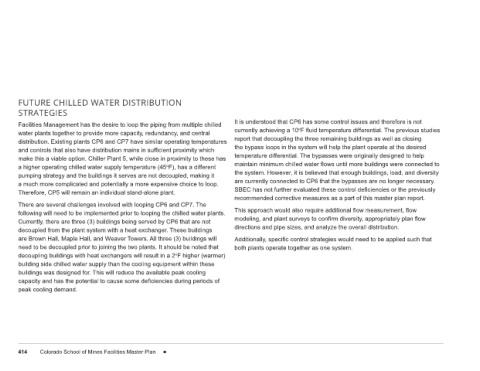Page 420 - Mines Facilities Plan
P. 420
currently achieving a 10ºF fluid temperature differential. The previous studies
maintain minimum chilled water flows until more buildings were connected to
the system. However, it is believed that enough buildings, load, and diversity
SBEC has not further evaluated these control deficiencies or the previously
are currently connected to CP6 that the bypasses are no longer necessary.
the bypass loops in the system will help the plant operate at the desired
ow
temperature differential. The bypasses were originally designed to help
recommended corrective measures as a part of this master plan report.
It is understood that CP6 has some control issues and therefore is not
report that decoupling the three remaining buildings as well as closing
ow
ow measurement, fl
This approach would also require additional fl
Additionally, specific control strategies would need to be applied such that
modeling, and plant surveys to confirm diversity, appropriately plan fl directions and pipe sizes, and analyze the overall distribution.
both plants operate together as one system.
distribution. Existing plants CP6 and CP7 have similar operating temperatures
make this a viable option. Chiller Plant 5, while close in proximity to these has
decoupling buildings with heat exchangers will result in a 2ºF higher (warmer)
following will need to be implemented prior to looping the chilled water plants.
Facilities Management has the desire to loop the piping from multiple chilled
need to be decoupled prior to joining the two plants. It should be noted that
a much more complicated and potentially a more expensive choice to loop.
are Brown Hall, Maple Hall, and Weaver Towers. All three (3) buildings will
building side chilled water supply than the cooling equipment within these
cient proximity which erent
pumping strategy and the buildings it serves are not decoupled, making it
decoupled from the plant system with a heat exchanger. These buildings
Currently, there are three (3) buildings being served by CP6 that are not
water plants together to provide more capacity, redundancy, and central
There are several challenges involved with looping CP6 and CP7. The
buildings was designed for. This will reduce the available peak cooling
a higher operating chilled water supply temperature (45ºF), has a diff
FUTURE CHILLED WATER DISTRIBUTION
capacity and has the potential to cause some deficiencies during periods of Colorado School of Mines Facilities Master Plan
STRATEGIES and controls that also have distribution mains in suffi Therefore, CP5 will remain an individual stand-alone plant. peak cooling demand. 414

